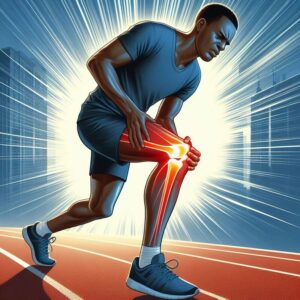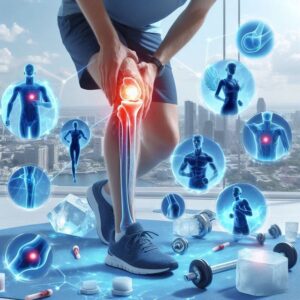After Jogging, Knee Joint Pain Management
Post-jogging knee joint soreness is prevalent among runners and can arise from several factors. The knee joint is an intricate structure comprised of bones, ligaments, tendons, and cartilage that provide stability and support to the body during movement. Repetitive stress on the knee joint, such as while jogging, can lead to inflammation and discomfort. This can lead to patellofemoral pain syndrome, characterised by discomfort in the area surrounding or behind the patella.
Possible factors contributing to runner’s knee include excessive usage, muscle imbalances, suboptimal running technique, and inappropriate footwear. Additionally, it can be exacerbated by jogging on rigid surfaces, engaging in uphill or downhill activities, and sudden increases in training intensity or duration. In addition, preexisting disorders such as pes planus or deficient hip musculature may contribute to knee joint discomfort during a running session. To effectively address post-jogging knee discomfort, it is essential to have a comprehensive understanding of the underlying reasons and develop appropriate prevention and treatment techniques accordingly.
Important Points to Remember
- Overuse, unsuitable footwear, and muscle imbalances are a few causes of common knee joint pain after jogging.
- Common causes of knee pain in runners include patellofemoral pain syndrome, iliotibial band syndrome, and meniscus injuries.
- Proper warm-up and cool-down, wearing supportive footwear, and maintaining a balanced training regimen are preventative measures for knee pain during and after running.
- After jogging, treatment options for knee joint pain may include rest, ice, compression, elevation, and over-the-counter pain medication.
- Strengthening and stretching exercises such as squats, lunges, and hamstring stretches can help relieve knee pain and prevent future injuries in runners.
- If the pain from a runner’s knee persists, worsens, or is associated with swelling, instability, or difficulty bearing weight, it is crucial to seek professional help.
- Tips for preventing knee problems after running include gradually increasing mileage, cross-training, and listening to your body for signs of overuse or injury.
Common Causes of Knee Pain in Runners
There are several common causes of knee pain in runners, and comprehending them is crucial for preventing and managing knee joint discomfort following jogging. Runners frequently get knee pain due to excessive usage. Excessive usage injuries that do not allow for sufficient healing can result in inflammation and discomfort in the knee joint. This can result in conditions such as patellofemoral pain syndrome, characterised by discomfort in the area around or behind the kneecap.
Muscular imbalances are a major contributing factor to the development of knee discomfort in runners. Imbalances in the muscles around the knee joint, whether due to tightness or weakness, can lead to poor biomechanics and increased strain when running. This highlights the need to preserve a harmonious combination of muscular strength and flexibility for runners. In addition, wearing ill-fitting shoes that do not provide adequate support to the knee joint and engaging in improper jogging techniques can also result in knee discomfort.
Additional variables contributing to knee discomfort in runners include running on unforgiving surfaces, inclines or declines, and sudden increases in training intensity or length. In addition, preexisting disorders such as pes planus or deficient hip musculature may contribute to knee joint discomfort during a running session. By acquiring knowledge about the primary causes, individuals may proactively prevent and effectively manage knee soreness in runners.

Preventative Measures for Knee Pain During and After Running
Runners can implement various measures to minimise the likelihood of experiencing knee discomfort during and after running. Wearing suitable footwear is one of the most effective preventive measures. Runners must own shoes that offer appropriate support and cushioning according to their foot structure and running technique. This can help reduce the impact on the knee joint, hence decreasing the likelihood of injury.
One more efficient preventative technique is progressively enhancing the intensity and length of exercise. Rapid increments in exercise volume can lead to excessive strain on the knee joint, leading to inflammation and discomfort. Runners can mitigate the danger of overuse difficulties by progressively increasing their runs’ distance and intensity, allowing their bodies to adapt and acclimatise.
Additionally, it is crucial to have robust and adaptable muscles surrounding the knee joint to prevent knee discomfort during and after jogging. Runners may enhance their biomechanics and reduce knee stress by including strength training for the quadriceps, hamstrings, and glutes, along with stretching exercises for the hip flexors and IT band. By adopting a proactive strategy and incorporating appropriate warm-up and cool-down routines, individuals may effectively prepare their bodies for exercise and facilitate recovery from running. This method empowers runners to maintain a sense of control over their knee health.
Treatment Options for Knee Joint Pain After Jogging
Patients experiencing knee joint soreness after running have various therapeutic options available. Rest is often the initial course of action for knee pain, allowing the body sufficient time to heal and recuperate from inflammation. Cryotherapy can also aid in alleviating pain and inflammation in the knee joint. According to some individuals, applying ice to uncomfortable areas for 15 to 20 minutes each day has been found to relieve pain and promote the healing process.
Ibuprofen and paracetamol are non-prescription analgesics that can effectively alleviate inflammation and discomfort when used with rest and cryotherapy. It is advisable to consult with your doctor before taking any drug, especially if you are unwell or concerned about your health.
Physical therapy might be beneficial in alleviating knee discomfort following a running session. A physical therapist can create a tailored regimen that focuses on your requirements, such as enhancing your running technique and biomechanics or addressing the muscles that support your knees through stretching and strengthening exercises. In some situations, bracing or taping may be recommended to provide additional support for the knee joint during physical training.
Strengthening and Stretching Exercises for Knee Pain Relief
Engaging in exercises that increase strength and flexibility is crucial for addressing knee pain and reducing the risk of future issues in individuals who run. Performing exercises that target the quadriceps, hamstrings, and glutes helps improve the stability and support of the knee joint during running. Exercises like squats, lunges, leg lifts, and hamstring curls enhance the effectiveness of exercises by strengthening the muscles. It is essential to perform these exercises with proper form and technique to prevent worsening knee discomfort.
Regular stretching exercises for the hip flexors, IT band, and calf muscles act as a protective barrier that enhances flexibility and reduces strain on the knee joint. Incorporating hip flexor stretches, IT band stretches, calf stretches, and foam rolling into your regimen will help protect your body. It is essential to perform these workouts consistently before and after running to preserve optimal muscle length and minimise the risk of injury. Consistency is crucial for achieving success in this endeavour.
Runners should attentively listen to their bodies and remain cognizant of any signs of discomfort or pain throughout physical activity. If some exercises elicit knee discomfort, it may be necessary to alter or abstain from them until the issue is remedied. Collaborating with trainers or physical therapists can help individuals create a customised training regimen that targets their unique requirements and objectives.

When to Seek Professional Help for Runner’s Knee
Although rest, ice treatment, and strengthening exercises can effectively treat most cases of a runner’s knee, there are instances where seeking expert help is necessary for knee joint discomfort following jogging. If knee discomfort continues despite conservative therapy, seeking consultation with a sports medicine physician or an orthopaedic expert is advisable.
Furthermore, it is imperative that you promptly seek medical attention if you encounter symptoms of a more severe condition, such as swelling, instability, or trouble putting weight on the injured limb. These symptoms may indicate more severe injuries, such as ligament tears or cartilage damage, which may need specialised treatment.
A healthcare professional may comprehensively assess the knee joint and provide a customised treatment plan based on the individual’s specific requirements and objectives. Additional diagnostic imaging treatments, such as X-rays or magnetic resonance imaging (MRI), may be necessary to assess the severity of the damage entirely. If traditional approaches to alleviating knee pain prove ineffective, more extreme interventions, such as surgery or corticosteroid injections, may be required.
Tips for Preventing Knee Problems After Running
In addition to the previously mentioned measures, runners can employ a multitude of ways to prevent knee problems after running. A vital recommendation is to vary your running terrain whenever feasible. Jogging on more yielding surfaces such as grass or trails can reduce the impact on the knee joints compared to jogging on harder surfaces like concrete or asphalt.
Runners, consider incorporating cross-training into your workout routine. Swimming, cycling, and strength training enhance your physical fitness. It is vital to diminish the recurrent strain on your knee joint generated by jogging. Receiving this reassurance can assist in maintaining your motivation and preventing injuries.
Ensuring enough nutrition and hydration prevents knee problems during a running session. Consuming a well-rounded diet rich in essential minerals such as vitamin D, omega-3 fatty acids, and calcium promotes robust bone health and reduces the risk of injuries. Appropriate hydration is crucial for facilitating optimal muscle activity and efficient recovery.
Runners, your body must have periods of rest and recovery to maintain good health and prevent injuries. You ensure sufficient sleep, employ appropriate recuperation methods like foam rolling or massage treatment, and take regular rest days—not indulgences but essential requirements. Properly tending to your body is crucial for facilitating its recovery from the strains of running, guaranteeing that you can enjoy your running endeavours.
In summary, knee joint discomfort from jogging is a prevalent issue among runners that can be attributed to several reasons, including excessive use, muscle imbalances, improper running technique, inappropriate footwear, and underlying abnormalities such as flat feet or weak hip muscles. Understanding the typical factors contributing to knee discomfort in runners is crucial for developing efficient strategies to avoid and cure it. To minimise the likelihood of knee joint pain while jogging and enhance running comfort, individuals should wear appropriate footwear, progressively increase training intensity and duration, maintain robust and flexible muscles surrounding the knee joint, consult professionals when needed, and adhere to guidelines for preventing knee issues post-running.
References
Using Compression Boots for Injury Prevention and Recovery – Kingsfield Fitness. https://kingsfieldfitness.com/blogs/kingsfield-fitness/using-compression-boots-for-injury-prevention-and-recovery
CBD For Knee Injury – Alive Market. https://www.alive-market.com/blogs/cbd-blogs/cbd-for-knee-injury
The post Managing Knee Joint Pain After Jogging appeared first on Hijama Therapy.
The Article Knee Pain After Jogging: How to Manage It appeared first on MCR Therapies.
The Article Knee Pain After Jogging: How to Manage It Was Found On https://limitsofstrategy.com


I really resonate with what you’ve shared about knee joint discomfort after jogging. As someone who’s spent a good chunk of time avoiding running due to persistent knee pain, I’ve learned a thing or two about how to manage it. It’s interesting how we often overlook the complexities of joint health and just focus on putting in miles, right?
It’s refreshing to hear you share your journey with knee pain and the lessons learned along the way. You’re spot on about how we often zoom in on the mileage while neglecting what our bodies really need. It’s a balance we all chase, isn’t it?